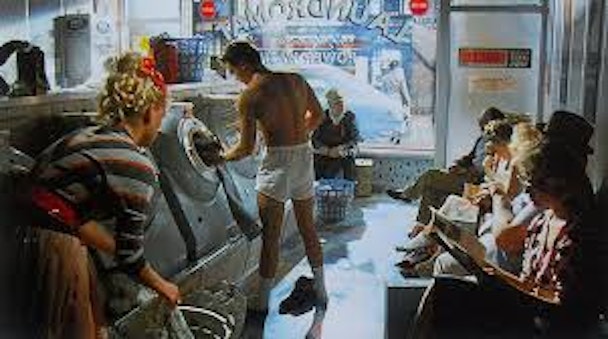Levi's Launderette Ad: how would today's marketers reimagine this classic ad campaign?
The Reimagining Advertising campaign, created in partnership with GumGum, is asking a panel of ten marketers how they would reimagine seminal ads from the pre-digital age to find out how today’s leading advertising thinkers would reinvent them with the current digital tools at their disposal.

In the second in the series, Jon Wilkins, Executive Chairman, Karmarama; Nicolas Roope, Executive Creative Director & Co-Founder, Poke; and Ben Plomion, SVP Marketing, GumGum reimagine Levi's seminal Laundrette ad.
Making a brand cool again
Bartle Bogle Hegarty’s Launderette ad for Levi’s truly demonstrates the power of advertising to breathe new life into staid brands. In 1982, Levi’s approached the agency for help in repositioning its classic 501 jeans. It had been many years since the brand was considered cool.
The launderette commercial was a breakthrough, the say the least. The spot featured a 1950’s launderette somewhere in middle America. In walks teen idol Nick Kamen, who strips down to his boxers and stuffs his clothes into a washer. In the background we hear Marvin s Gaye’s I Heard It Through The Grapevine.
The ad went on to spawn a whole genre of Levi’s 501 ads, including one with a young Brad Pitt who’s released from jail in his boxers. Fortunately for him, a young woman drives up and throws him a pair of jeans.
The Launderette ad was also an early example of integrated marketing. Marvin Gaye’s soundtrack was re-released, this time with the Levi’s logo on the record sleeve. Sales went through the roof.
Levi’s, meanwhile, enjoyed an 800% boost in sales within a year of the 501's re-launch.

How would our panelists reimagine these iconic ad?
New music, more sizzle, and a lot more sociability: Jon Wilkins, executive chairman, Karmarama
In the 1980s, when this ad came out, advertising was all about simulating reality, and that could be cool. Today’s consumers don’t have that belief system any more. To be cool, advertising needs to be engaging. Consumers want to add to and share campaign assets.
Other differences include that the Levi’s launderette ads used old music to set the tone, but that won’t work for today’s audience. And the Nick Kamen ad targeted guys aged 16 to 24, but you can’t use a single 30-second or 60-second spot to communicate with that audience anymore. Today’s millennials are living in an online Netflix-tablet universe.
To reinvent this ad, I’d focus on creating an event, similar to what Kanye West did at Madison Square Garden for the launch of his Yeezy Season 3 collection. I’d hire a big star, like Jay Z, to create new music, which is introduced through the ads. He may be open to it because today the musician’s path to the market is through partnerships.
Like the Kanye launch, I’d live stream the event, which will immediately create a number of content-based assets that consumers can use and share. We’d build content that distributes itself, rather than trying to buy your way into an audience.
The secret lives of youths: Nicolas Roope, executive creative director & co-founder, Poke
This ad benefited from perfect timing and a cultural alignment: music, cultural and style revivals, with loosening sexual attitudes and a more feminine male expression. At the time, teenagers still blushed at the sight of male flesh.
Today, allure isn’t about subtle suggestion, it’s personality and influence based. To do this ad today, I’d use an influencer like YouTuber PewDiePie, rather than a model like Nick Kamen.
The idea: We’d create a series of insider’s jokes that PewDiePie and other YouTube-based characters incorporate into their videos. We’d then reference those jokes in our mainstream ads. As followers of these YouTube influencers, millennials will pick up on those jokes, and immediately understand their references.
Father and daughter may watch the same ad, or pass the same poster, but both get completely different things out of it. To dad the scene is innocuous, but to daughter it has a rebellious, radical angle.
In terms of music, we’d do away with the retro stuff and replace it with some kind of grimy mash up, with sounds that may or may not be farts (those with inside knowledge will know it’s farts because PewDiePie records them on his channel).
And like the original ad, we record a single and use the huge community engagement to push it to the top of the charts (as has been done already with Imogen Heap). Farts included.
Choose your adventure: Ben Plomion, SVP Marketing, GumGum
The music in the original ad does a great job in inspiring a feeling and setting the mood. But music is individual, and reflects our own style. Why not let the viewer create in real time the mood of the ad? That way, the viewer gets to choose his or her own adventure.
To execute this campaign, I’d use rich media and video to create a modern take on 'Choosing your own adventure.' I’d begin with the music, letting consumers select a song from four popular genres. The ad could use that song, or use a less well-known one recommended by Spotify or Pandora.
The viewer can then select the scenario of their choosing, based on their own idea of adventure (e.g, “road trip”, “city at night”, “day at the beach” etc.).
The choices would lead to a custom ad, built on the fly in real time, featuring a shirtless video of the guy in nothing but his style of Levi’s. At the end of each ad, the viewer has a chance to take a “snapshot” of the adventure, to store in an online photo album.
Content created with:

GumGum
GumGum is a contextual-first global advertising technology company that captures people’s attention, without the use of personal data. We believe that a digital...
Find out more
